The Parthenon Enigma (35 page)
Read The Parthenon Enigma Online
Authors: Joan Breton Connelly

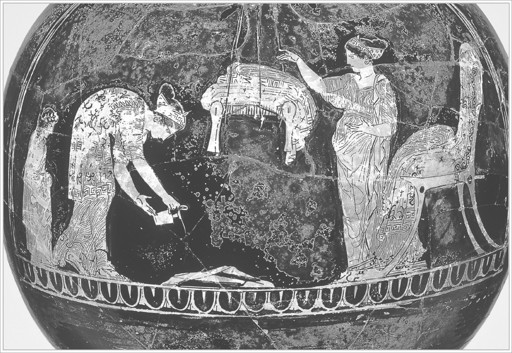
Women perfuming fabric on swinging stool. Oinochoe, Meidias Painter, ca. 420–410 B.C. (illustration credit
ill.59
)
In the Greek world, there were three great necessities for such elaborately woven fabrics: the baby’s
swaddling clothes, the bride’s wedding dress, and the corpse’s shroud. The word “peplos” applies to all three; indeed, it simply means an “uncut length of heavy woolen cloth.” Depending on the context, we find the word “peplos” translated as “robe,” “dress,” “tapestry,” “awning,” “swaddling clothes,” and “shroud.”
106
The
weaving of fabrics with figural designs took many months, even years, and would have been one of the chief occupations of women within the Greek household.
Penelope is the archetypal woman at the loom, painstakingly weaving (and unweaving) a shroud for her father-in-law,
Laertes, across the years of her husband’s absence, as recounted in the
Odyssey
. Shrouds were prepared well in advance, anticipating the
deaths of family members. Even to this day in certain Greek families, luxury sheets or embroidered cloths are set aside for the wrapping of bodies at the time of burial.
From antiquity through the Middle Ages, the shroud was a highly charged signifier, proof that a death had occurred. One need only think of the rich symbolism invested in the so-called
Shroud of Turin, which, forgery or not, has so potently symbolized the death and resurrection of Christ.
107
The presence of three shrouds in the central panel of the Parthenon frieze clearly communicates that three deaths are imminent. The stark white flesh of the youngest daughter, caught in the process of changing into her funerary dress, signals the impending tragedy is already in train, the time of sacrifice ineluctably near.
By this new reading we have three girls preparing for death (
this page
). The youngest goes first, so her peplos is being unfolded and displayed. The oldest daughter, second from left, is handing her stool to her mother. The daughter at far left stands frontally, her garment still folded and carried upon her head. According to the myth, the
oracle at Delphi had demanded the death of one daughter.
Apollodoros tells us this was to be the youngest of the three.
108
Praxithea and Erechtheus agree to that girl’s sacrifice, unaware that the sisters have pledged the
famous oath, that if one of them should die, so will the others. That the other two are shown carrying their own funeral dresses with unannounced plans of leaping from the Acropolis ironically foreshadows an even greater sacrifice than the parents expected to make.
What is the object cradled in the arm of the girl at far left? Though damaged and difficult to read, the shape of a lion’s paw has been deciphered at its lower right corner.
109
This has led to its identification as a footstool, presumably for use with one of the
stools carried by the girls.
110
Lion’s paws, however, are used to adorn not only footstools but the legs of small metal chests, including
jewelry boxes. Images from vase painting regularly show such boxes cradled in the arms of serving maids. Reading the frieze panel as a dressing scene prior to
virgin sacrifice, we can understand this object to hold the precious ornaments with which the maiden offering will be adorned.
111
The second-century
A.D.
orator
Aelius Aristides described the preparations for the sacrifice of Erechtheus and
Praxithea’s daughter as follows: “And her mother, dressing her up, led her just as if she were sending her to a spectacle.”
112
A red-figured pyxis in Paris provides an excellent parallel for this dressing scene. It shows preparations for the costuming of a maiden about to be married (below).
113
The bride is seated at the left and looks up at the wedding dress dramatically held out to her by a serving maid. At far right, a second servant carries a small metal box containing the bride’s jewelry, the finishing touches to her wedding
kosmos
. The same can be seen on the Parthenon’s east frieze. Father and sacrificial daughter display the funerary dress she is about to put on. At left, one of her sisters carries the box of jewelry with which she will be adorned just prior to her sacrifice.
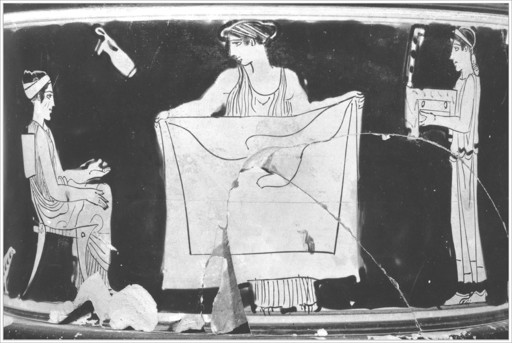
Bridal
kosmos
with dress and jewelry displayed before bride. Pyxis, Painter of the Louvre Centauromachy, ca. 430 B.C. (illustration credit
ill.60
)
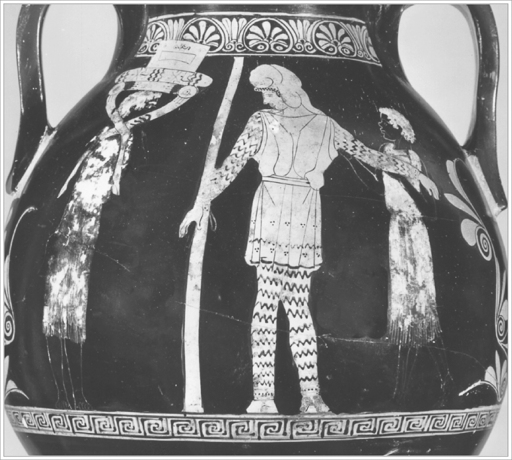
Andromeda dressed for sacrifice to sea dragon, Ethiopian servants bring clothing and jewelry. Pelike, workshop of the Niobid Painter, ca. 460 B.C. © 2014, Museum of Fine Arts, Boston. (illustration credit
ill.61
)
The princess Andromeda, lashed to stakes and left for an insatiable sea dragon, is depicted in Greek vase painting with very similar
iconography.
114
When a sea monster terrorized the Ethiopian coastline, the Delphic oracle proclaimed that the beast could be placated only through the sacrifice of the king’s daughter. And so Andromeda was led to a cliff overlooking the sea and chained to great rocks to prevent her from fleeing, should she not agree with her father’s act of selflessness. A red-figured vase in Boston shows the princess in her finest raiment and jewelry, ready to meet
death (above).
115
An Ethiopian servant approaches from the left, upon his head a folding stool with a small chest resting atop what appears to be a cushion but what surely represents the clean and carefully folded fabric
of Andromeda’s funerary dress.
On the reverse of the vase (facing page), a second black attendant carries in even more trimmings for Andromeda’s
kosmos:
another jewelry box and a small jar of fragrant oil. Indeed, more is more when it comes to dressing up a
virgin victim for sacrifice. Andromeda’s forlorn father, King Kepheus, gravely supervises the preparations, rather as King Erechtheus does on the Parthenon frieze, creating the same excruciating anticipation. In both images, we have the tragic ambiguity of a dressing ritual equally befitting a wedding and a
virgin sacrifice.
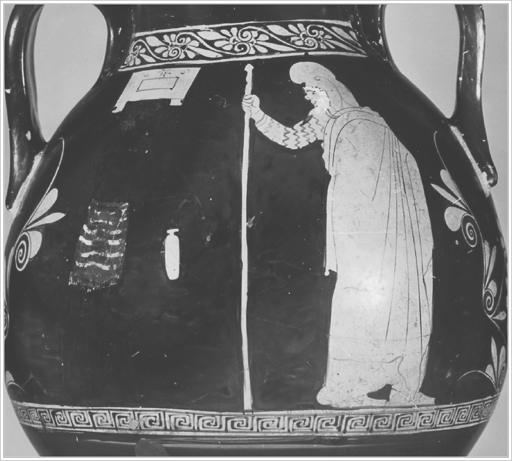
King Kepheus oversees sacrifice of his daughter Andromeda; Ethiopian servant approaches. Pelike, ca. 460 B.C. © 2014, Museum of Fine Arts, Boston. (illustration credit
ill.62
)
Two groups of six seated Olympians turn their backs on the central panel of the east frieze (
this page
,
this page
, and
this page
). To the south we see
Hermes,
Dionysos,
Demeter,
Ares,
Hera, and
Zeus. Just beside Hera stands a winged figure who is variously identified as Nike,
Iris, or
Hebe (goddess of youth).
116
At the north side we find
Athena,
Hephaistos,
Poseidon,
Apollo,
Artemis (following page),
Aphrodite, and a standing
Eros.
117
Strangely, the gods turn their backs on the goings-on of the central panel, looking out toward the groups of men and maidens filling the rest of the east frieze. Were this a historical Panathenaic procession, the gods would certainly be taking notice of the culminating moment of the ritual.
118
If it were the presentation of the peplos to Athena, the goddess would hardly be so indifferent to her own birthday offering. Athena’s body language would then suggest a callous rejection of her people’s gift (above), an event without sense or precedent.
119
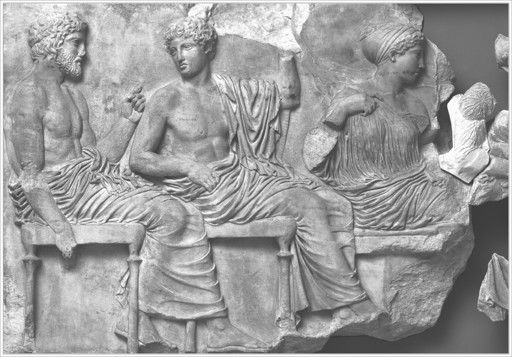
Poseidon, Apollo, and Artemis, east frieze, slab 6, Parthenon. (illustration credit
ill.63
)
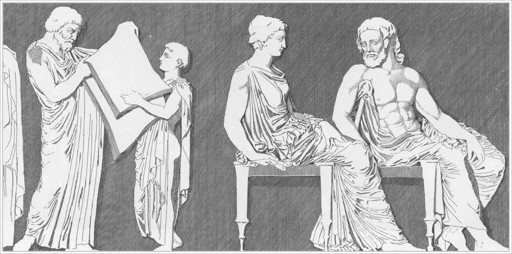
Erechtheus and daughter display fabric, Athena and Hephaistos turn away, east frieze, Parthenon. Stuart and Revett,
Antiquities of Athens
2: Pl. 23. (illustration credit
ill.64
)
